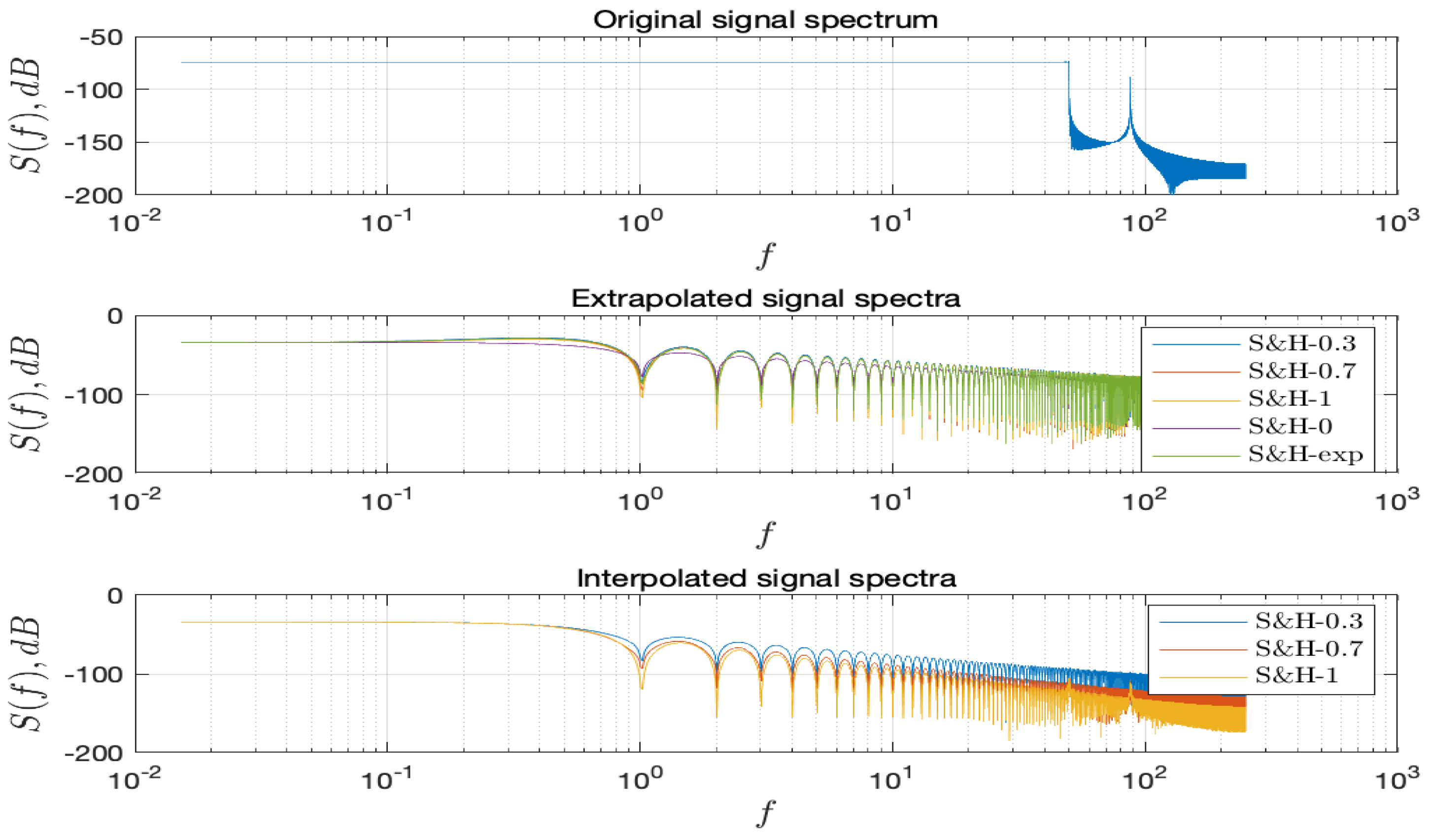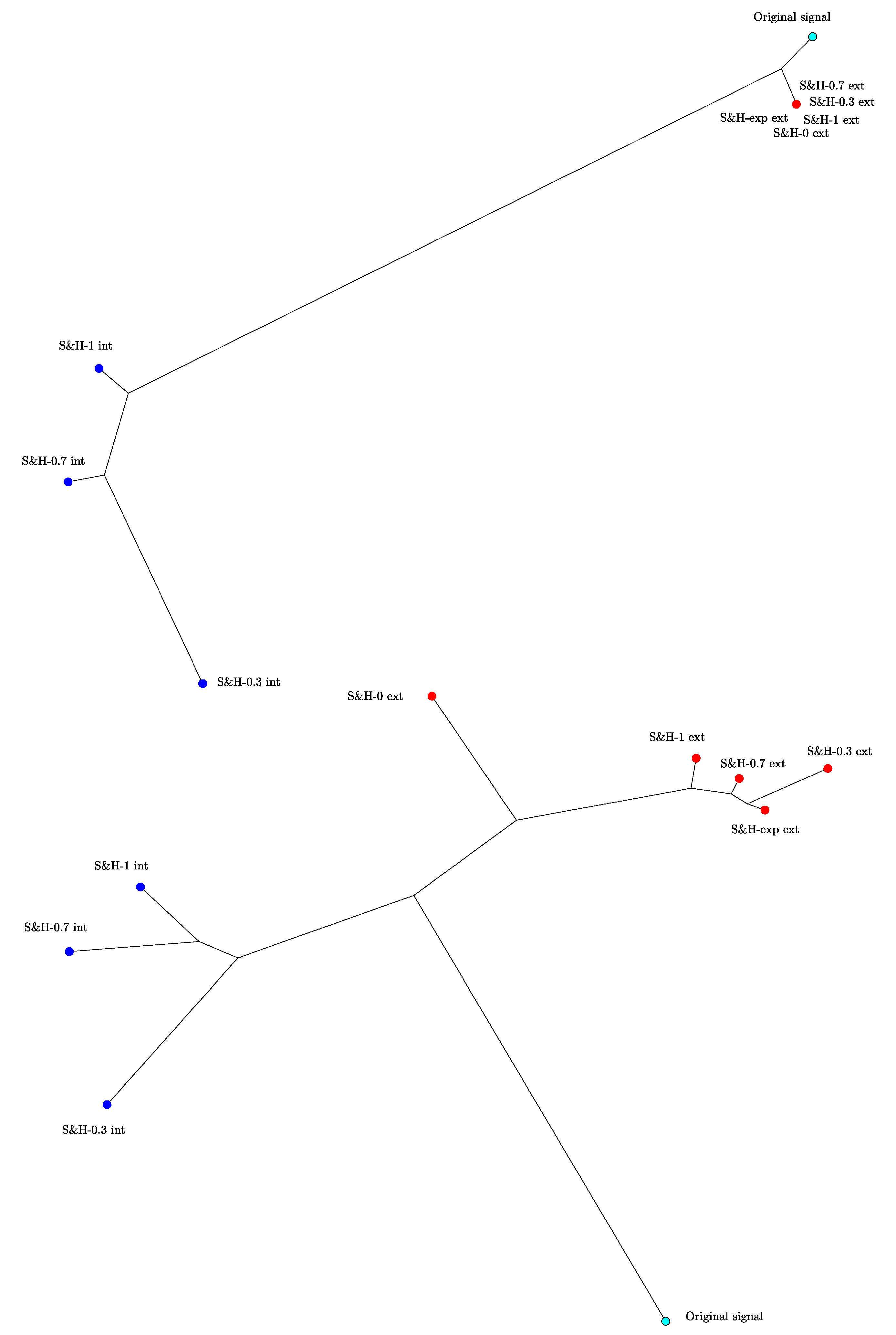A Review of Sample and Hold Systems and Design of a New Fractional Algorithm
Abstract
:1. Introduction
2. Fundamental Concepts
- 1.
- the domain of the discrete signal is a discrete subset of the domain of the continuous signal,
- 2.
- the range of the discrete signal is also a discrete subset of the range of the continuous signal,
- 3.
- both signals, discrete and continuous, assume the same values at the intersection domains,
3. Sampling and Reconstruction
3.1. The S&H Reconstruction by Extrapolation
3.1.1. The Zero Order Sample and Hold
3.1.2. The First-Order Sample and Hold
3.1.3. The Fractional-Order Sample and Hold
3.1.4. The exponential order sample and hold
3.1.5. The -Order Sample and Hold
3.2. The S&H Reconstruction by Interpolation
4. The Transfer Functions of the S&H
5. Conclusions
Author Contributions
Funding
Conflicts of Interest
Abbreviations
| BLT | bilateral Laplace transform |
| FT | Fourier transform |
| HC | Hierarchical clustering |
| LT | Laplace transform |
| MDS | Multidimensional scaling |
| S&H | Sample and hold |
| S&H-0 | Zero order sample and hold |
| S&H-1 | First-order sample and hold |
| S&H- | Fractional-order sample and hold |
| S&H-exp | Exponential order sample and hold |
| S&H- | -order sample and hold |
References
- Ortigueira, M.D. Fractional Calculus for Scientists and Engineers; Lecture Notes in Electrical Engineering; Springer: Berlin/Heidelberg, Germany, 2011. [Google Scholar] [CrossRef]
- Machado, J.A.T.; Mainardi, F.; Kiryakova, V. Fractional calculus: Quo vadimus? (where are we going?). Fract. Calc. Appl. Anal. 2015, 18, 495–526. [Google Scholar] [CrossRef]
- Ortigueira, M.D. An Introduction to the Fractional Continuous-Time Linear Systems: The 21(st) Century Systems. IEEE Circuits Syst. Mag. 2008, 8, 19–26. [Google Scholar] [CrossRef] [Green Version]
- Ortigueira, M.D.; Machado, J.T. Fractional derivatives: The perspective of system theory. Mathematics 2019, 7, 150. [Google Scholar] [CrossRef] [Green Version]
- Valério, D.; da Costa, J.S. An Introduction to Fractional Control; Control Engineering; IET: London, UK, 2012. [Google Scholar]
- Ortigueira, M.D.; Valério, D. Fractional Signals and Systems; De Gruyter: Berlin, Germany; Boston, MA, USA, 2020. [Google Scholar] [CrossRef]
- Oppenheim, A.V.; Willsky, A.S.; Hamid, S. Signals and Systems, 2nd ed.; Prentice-Hall: Upper Saddle River, NJ, USA, 1997. [Google Scholar]
- Garrido, A.J.; De la Sen, M.; Bárcena, R. Approximate models to describe real sampling and hold processes based on multirate sampling techniques. In Proceedings of the American Control Conference, Chicago, IL, USA, 28–30 June 2000; Volume 1, pp. 195–199. [Google Scholar] [CrossRef]
- Kester, W. The Data Conversion Handbook. 2005. Available online: http://www.analog.com/library/analogdialogue/archives/39-06/data_conversion_handbook.html (accessed on 30 September 2020).
- Proakis, J.G.; Manolakis, D.G. Digital Signal Processing: Principles, Algorithms, and Applications; Prentice Hall: Upper Saddle River, NJ, USA, 2007. [Google Scholar]
- Pichler, H.; Pavuza, F.G.; Sommer, T. The exponential-hold circuit, properties and applications. In Proceedings of the 1993 IEEE Instrumentation and Measurement Technology Conference, Irvine, CA, USA, 18–20 May 1993; pp. 745–750. [Google Scholar] [CrossRef]
- Sheen, I.E.; Tsai, J.S.H.; Shieh, L.S. Optimal digital redesign of continuous-time systems using fractional-order hold. Optim. Control Appl. Meth. 1997, 18, 399–422. [Google Scholar] [CrossRef]
- Barcena, R.; de la Sen, M.; Sagastabeitia, I. Improving the stability properties of the zeros of sampled systems with fractional order hold. IEE Proc. Control Theory Appl. 2000, 147, 456–464. [Google Scholar] [CrossRef]
- Machado, J.A.T. Fractional order modelling of fractional-order holds. Nonlinear Dyn. 2012, 70, 789–796. [Google Scholar] [CrossRef] [Green Version]
- Bernhardsson, B. The predictive first order hold circuit. In Proceedings of the 29th IEEE Conference on Decision and Control, Honolulu, HI, USA, 5–7 December 1990; IEEE: Piscataway, NJ, USA, 1990. [Google Scholar]
- de Carvalho, J.L.M. Dynamical Systems and Automatic Control; Prentice Hall: Hertfordshire, UK, 1993. [Google Scholar]
- Dorf, R.C.; Bishop, R.H. Modern Control Systems; Pearson: London, UK, 2011. [Google Scholar]
- Haykin, S. Communication Systems; John Wiley & Sons: Hoboken, NJ, USA, 2008. [Google Scholar]
- Cha, S.-H. Comprehensive Survey on Distance/Similarity Measures between Probability Density Functions. Int. J. Math. Model. Methods Appl. Sci. 2007, 1, 300–307. [Google Scholar]
- Torgerson, W.S. Theory and Methods of Scaling; Wiley: New York, NY, USA, 1958. [Google Scholar]
- Sammo, J. A nonlinear mapping for data structure analysis. IEEE Trans. Comput. 1969, 18, 401–409. [Google Scholar] [CrossRef]
- Kruskal, J. Multidimensional Scaling; Sage Publications: Newbury Park, CA, USA, 1978. [Google Scholar]
- Kaufman, L.; Rousseeuw, P.J. Clustering Algorithms; Wiley-Interscience: Hoboken, NJ, USA, 2005. [Google Scholar]
- Ortigueira, M.D. The comb signal and its Fourier transform. Signal Process. 2001, 81, 581–592. [Google Scholar] [CrossRef] [Green Version]
- Ortigueira, M.D.; Torres, D.F.M.; Trujillo, J.J. Exponentials and Laplace transforms on nonuniform time scales. Commun. Nonlinear Sci. Numer. Simul. 2016, 39, 252–270. [Google Scholar] [CrossRef] [Green Version]
- Hartigan, J.A. Clustering Algorithms; John Wiley & Sons: New York, NY, USA, 1975. [Google Scholar]
- Shepard, R.N. The analysis of proximities: Multidimensional scaling with an unknown distance function. Psychometrika 1962, 27, 125–140. [Google Scholar] [CrossRef]
- Kruskal, J. Multidimensional scaling by optimizing goodness of fit to a nonmetric hypothesis. Psychometrika 1964, 29, 1–27. [Google Scholar] [CrossRef]
- Székely, G.J.; Rizzo, M.L. Hierarchical Clustering via Joint Between-Within Distances: Extending Ward’s Minimum Variance Method. J. Classif. 2005, 22, 151–183. [Google Scholar] [CrossRef]
- Machado, J.A.T. Visualizing Non-Linear Control System Performance by Means of Multidimensional Scaling. ASME Comput. Nonlinear Dyn. 2013, 8, 041017. [Google Scholar] [CrossRef] [Green Version]
- Deza, M.M.; Deza, E. Encyclopedia of Distances; Springer: Berlin/Heidelberg, Germany, 2009. [Google Scholar]
- Machado, J.A.T.; Lopes, A.M. Multidimensional Scaling Locus of Memristor and Fractional Elements. J. Adv. Res. 2020, 25, 147–157. [Google Scholar] [CrossRef] [PubMed]
- Machado, J.A.T.; Lopes, A.M. newblock Multidimensional Scaling and Visualization of Patterns in Prime Numbers. Commun. Nonlinear Sci. Numer. Simul. 2020, 83, 105128. [Google Scholar] [CrossRef]
- Marvasti, F. A new method to compensate for the sample-and-hold distortion. IEEE Trans. Acoust. Speech Signal Process. 1985, 33, 738–741. [Google Scholar] [CrossRef]
- Wang, Z. The fastest sample-and-hold circuit. Microelectron. J. 1990, 21, 49–52. [Google Scholar] [CrossRef]
- Van De Plassche, R. Sample-and-hold amplifiers. In Integrated Analog-To-Digital and Digital-To-Analog Converters; Springer: Boston, MA, USA, 1994; p. 264. [Google Scholar] [CrossRef]
- Taylor, H.R. Sample and hold circuits. In Data Acquisition for Sensor Systems; Springer: Boston, MA, USA, 1997. [Google Scholar] [CrossRef]
- Abolhasani, A.; Tohidi, M.; Hadidi, K.; Khoei, A. A new high-speed, high-resolution open-loop CMOS sample and hold. Analog. Integr. Circuits Signal Process. 2014, 78, 409–419. [Google Scholar] [CrossRef]
- Psychalinos, C.; Elwakil, A.; Maundy, B.; Allagui, A. Analysis and realization of a switched fractional-order-capacitor integrator. Int. J. Circuit Theory Appl. 2016, 44, 2035–2040. [Google Scholar] [CrossRef]
- Pelgrom, M. Analog-to-Digital Conversion; Springer: Cham, Switzerland, 2017. [Google Scholar]
- Yuz, J.I.; Goodwin, G.C.; Garnier, H. Generalised hold functions for fast sampling rates. In Proceedings of the 43rd IEEE Conference on Decision and Control, Atlantis, Bahamas, 14–17 December 2004; Volume 2, pp. 908–1913. [Google Scholar] [CrossRef]
- Trivedi, R. Low Power and High Speed Sample-and-Hold Circuit. In Proceedings of the 2006 49th IEEE International Midwest Symposium on Circuits and Systems, San Juan, PR, USA, 6–9 August 2006; pp. 453–456. [Google Scholar] [CrossRef]
- De la Sen, M. About Optimal Fractional Hold Circuits for Inter-sample Output Reconstruction in Sampled-data Systems. Sensors 2007, 7, 3146–3155. [Google Scholar] [CrossRef] [PubMed] [Green Version]
- Nishi, M.; Ishitobi, M. Sampled-Data Models for Nonlinear Systems with a Fractional-Order Hold. In Proceedings of the 18th IEEE International Conference on Control Applications Part of 2009 IEEE Multi-Conference on Systems and Control, Saint Petersburg, Russia, 8–10 July 2009; pp. 153–158. [Google Scholar] [CrossRef]
- Nishi, M.; Ishitobi, M. Sampled-data models for affine nonlinear systems using a fractional-order hold and their zero dynamics. Artif. Life Robot. 2010, 15, 500–503. [Google Scholar] [CrossRef]
- Zeng, C.; Xiang, S.; He, Y.; Ding, Q. Nonlinear Sampled-Data Systems with a Generalized Hold Polynomial-Function for Fast Sampling Rates. J. Syst. Sci. Complex. 2019, 32, 1572–1596. [Google Scholar] [CrossRef]




Publisher’s Note: MDPI stays neutral with regard to jurisdictional claims in published maps and institutional affiliations. |
© 2020 by the authors. Licensee MDPI, Basel, Switzerland. This article is an open access article distributed under the terms and conditions of the Creative Commons Attribution (CC BY) license (http://creativecommons.org/licenses/by/4.0/).
Share and Cite
Ortigueira, M.D.; Machado, J.T. A Review of Sample and Hold Systems and Design of a New Fractional Algorithm. Appl. Sci. 2020, 10, 7360. https://doi.org/10.3390/app10207360
Ortigueira MD, Machado JT. A Review of Sample and Hold Systems and Design of a New Fractional Algorithm. Applied Sciences. 2020; 10(20):7360. https://doi.org/10.3390/app10207360
Chicago/Turabian StyleOrtigueira, Manuel Duarte, and José Tenreiro Machado. 2020. "A Review of Sample and Hold Systems and Design of a New Fractional Algorithm" Applied Sciences 10, no. 20: 7360. https://doi.org/10.3390/app10207360
APA StyleOrtigueira, M. D., & Machado, J. T. (2020). A Review of Sample and Hold Systems and Design of a New Fractional Algorithm. Applied Sciences, 10(20), 7360. https://doi.org/10.3390/app10207360





